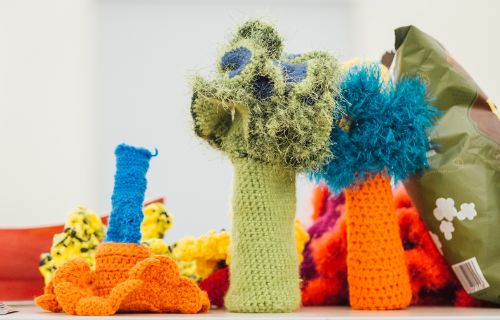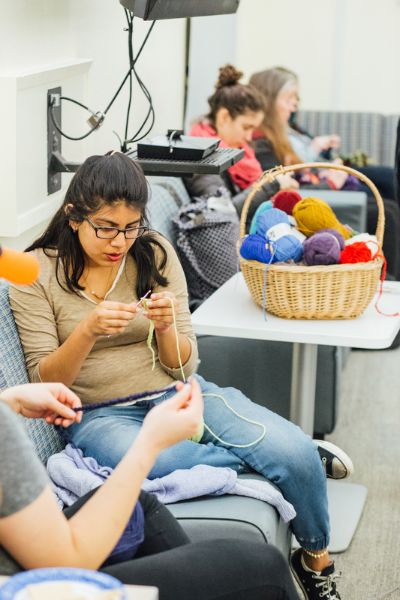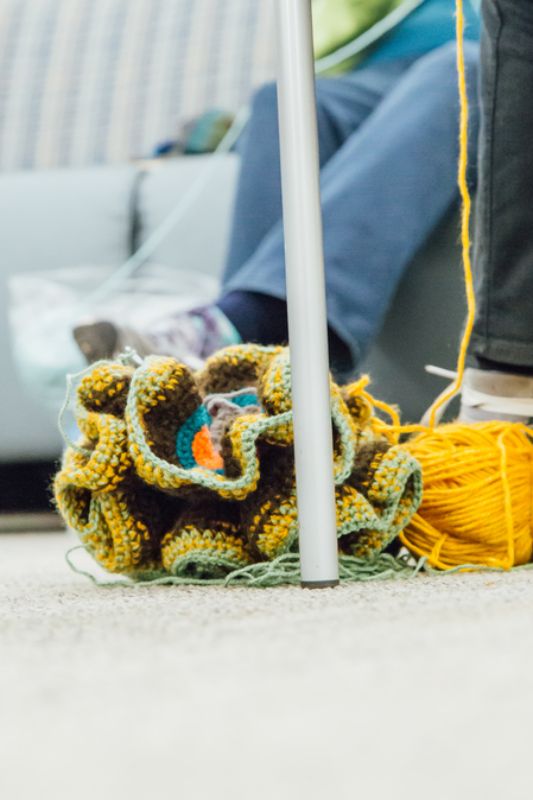Stitch by stitch, row by row, a bright and vibrant coral reef is growing at UC Santa Cruz.
It's made out of wool, but it looks a lot like the real thing, with swirls, loops, coils, and squiggles galore.
The Crochet Coral Reef is a massive participatory art project that was created in 2005 by the sisters Christine and Margaret Wertheim of the Institute for Figuring, a Los Angeles–based organization that delves into the aesthetic and poetic aspects of the sciences.
Since then, the project has spread across the globe. In fact, the Crochet Coral Reef is the biggest participatory science and art project on Earth at the moment, according to the Wertheim sisters.
The Mary Porter Sesnon Gallery is running an exhibition of the Wertheim sisters' art, Crochet Coral Reef: CO2CA-CO2LA Ocean, through May 6, 2017. The exhibit features the coral reef crochet of the Wertheim sisters and their collaborators.
The sisters, who grew up in Queensland, Australia, near the Great Barrier Reef, describe it as a worldwide “wooly celebration of the intersection of higher geometry and feminine handicraft, and a testimony to the disappearing wonders of the marine world.” Since the project’s humble beginnings, it has expanded to include “satellite coral reef” projects in 35 cities and countries worldwide, and as far-flung as Ireland, Germany, and Latvia.
Santa Cruz satellite
One of those satellites has been established at UC Santa Cruz, under the auspices of UC Santa Cruz’s Institute of the Arts and Sciences (IAS), which is funding and organizing the project.
So far, more than 200 UC Santa Cruz students, and 200 area residents, have contributed to the satellite reef, which will go on display at the Seymour Marine Discovery Center starting on May 4, 2017. The participants are hoping the display will look like a three-dimensional grotto of coral.
It would be a mistake to call the satellites spin-off projects because each satellite reef is part of one enormous whole. In this sense, the project mirrors nature; every coral reef is the work of thousands of tiny organisms.
Crochet soiree
One chilly January evening at UC Santa Cruz, a group of crochet enthusiasts—a dozen students and four Santa Cruz community members—met for a student-led crochet circle at a multipurpose space known as the Red Room at Rachel Carson College to work on the satellite project. They concentrated on their work, adding wooly flourishes to the simulated reef.
Some students sat stock-still, in total silence, as they worked, while others chatted away. “I want to be spontaneous,” one whispered to a friend. “I want to go against the grain. I love how free-spirited this is!”
No one in the crochet circle strives for absolute perfection. To do so would be unnatural.
“There is something really beautiful about (the fact that) organic patterns aren’t perfect,” said Sarah Skikne, a Ph.D. student in environmental studies, and a 2016 Switzer Environmental Fellow, awarded for her research in environmental science. “You make mistakes and you add mistakes.”
Artmakers say the reef-building experience is deeply meditative and a great excuse to shut off annoying smartphones and other devices. “It is a material thing that demands the attention of your eyes and hands in a continuous way so you can't really get distracted by other things,’’ said Sophia DiMatteo (Merrill ’17, history of art and visual culture), one of three interns selected for year-long paid internships with the IAS. DiMatteo and fellow interns Gracia Brown (College 10 ’18) and Lucy Ashton (Kresge ’18, history of art and visual culture) are leading the student crochet circles.
Replicating life forms
But the project is more than just relaxing. The crocheting circles heighten awareness of coral reefs and their plight, while emphasizing the power of positive action, said Rachel Nelson, curator and program manager at the IAS. She also teaches in the History of Art and Visual Culture Department. At the same time, she said, “this is a way to talk about the science and math of coral reefs.”
That’s because the crocheting circles use a method that allows them to make fanciful but convincing re-created life forms. The technique, developed in 1997 by Cornell mathematician Daina Taimina, is called “hyperbolic crochet.”
By following a surprisingly basic algorithm, but also varying and “mutating” the pattern, the crochet artist can replicate the squiggles of “brain coral,” and make all sorts of fringed, loopy, curly, swirly, crenelated forms that can be found in life forms under the sea.
In the Red Room, members of the Santa Cruz community sat next to their undergraduate cohorts, offering advice and chatting freely. One of them, Kathleen Roberts (Cowell ’71, art), loves the free-form aspect of the project. “I’ve taught so many people how to crochet,’’ she said, referring to UC Santa Cruz students involved with the project. “Most have never crocheted before, but their pieces are going to be (part of the project.)”
That imperfection is perfectly fine with Roberts, who says that crocheting is supposed to be “funky. Overplanning simply doesn’t work.”
Roberts is happy with the "come one, come all" aspect of the crocheting circles, which have been meeting weekly. She was amazed when she showed up to one of the early sessions for the coral reef project on campus, “and there were 175 people at Stevenson College, and all this yarn.”
Men with yarn
Though the website describes crocheting as a feminine handicraft, the crocheting circles have attracted an unusual number of male student participants, Nelson said. “And a fair amount of them already knew how to crochet” before joining the circles, she added. “It took away the gender expectations.”
Nelson said that in any given satellite project, only 3 percent of the participants are men. “At UC Santa Cruz, it’s more like 30 percent,’’ she said.
She attributed that high participation to an art course taught by Art Department lecturer Kathleen Perry, who asked her students to take part in the Crochet Coral Reef.
To find out more about the crochet circles at UC Santa Cruz and the ongoing project, visit the homepage for the satellite project. The contact email for the crochet group is ias@ucsc.edu.
Participants are also invited to crochet on their own and leave the results at a drop-off box set up at the Institute of the Arts and Sciences, room 204, or create their own crocheting groups if they wish. If they choose, they can even mail in their crochet coral projects to:
The Institute of the Arts and Sciences
UC Santa Cruz MS: Porter Faculty Services
1156 High Street
Santa Cruz, CA 95064





